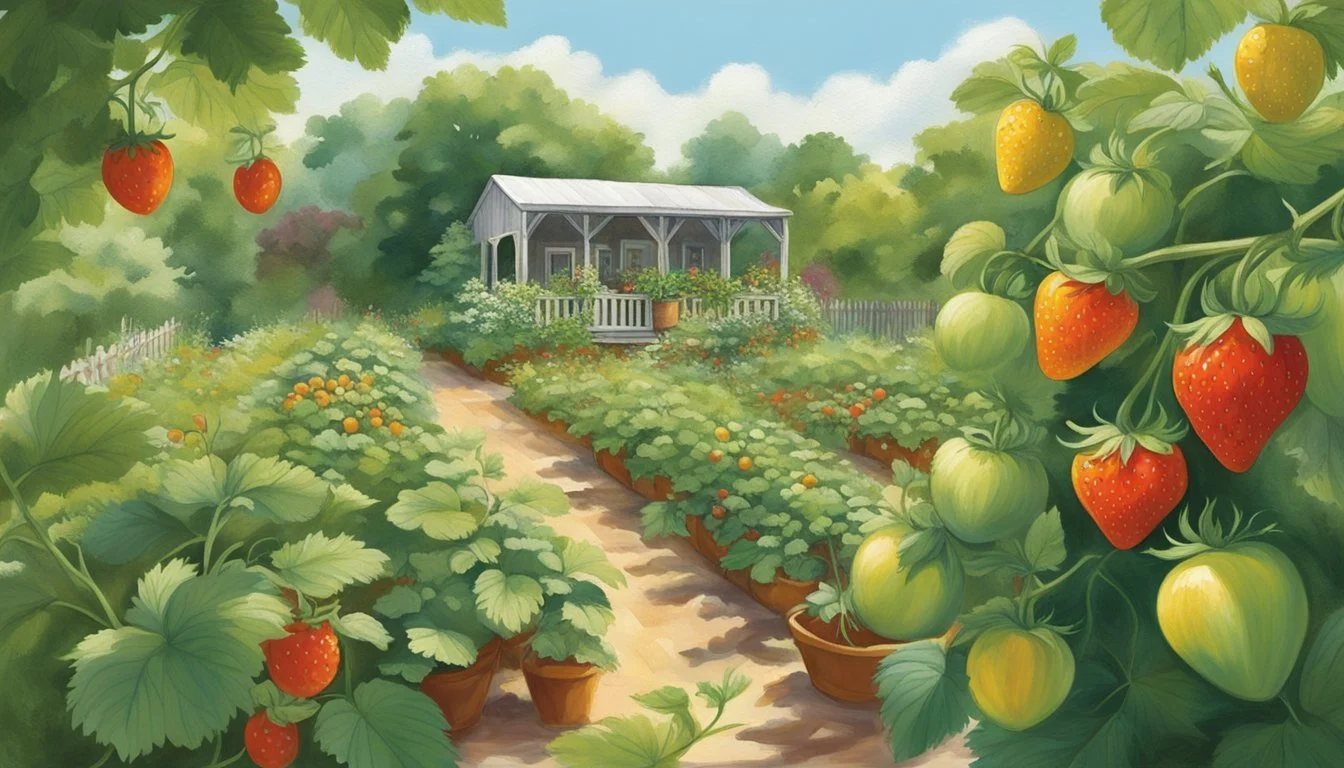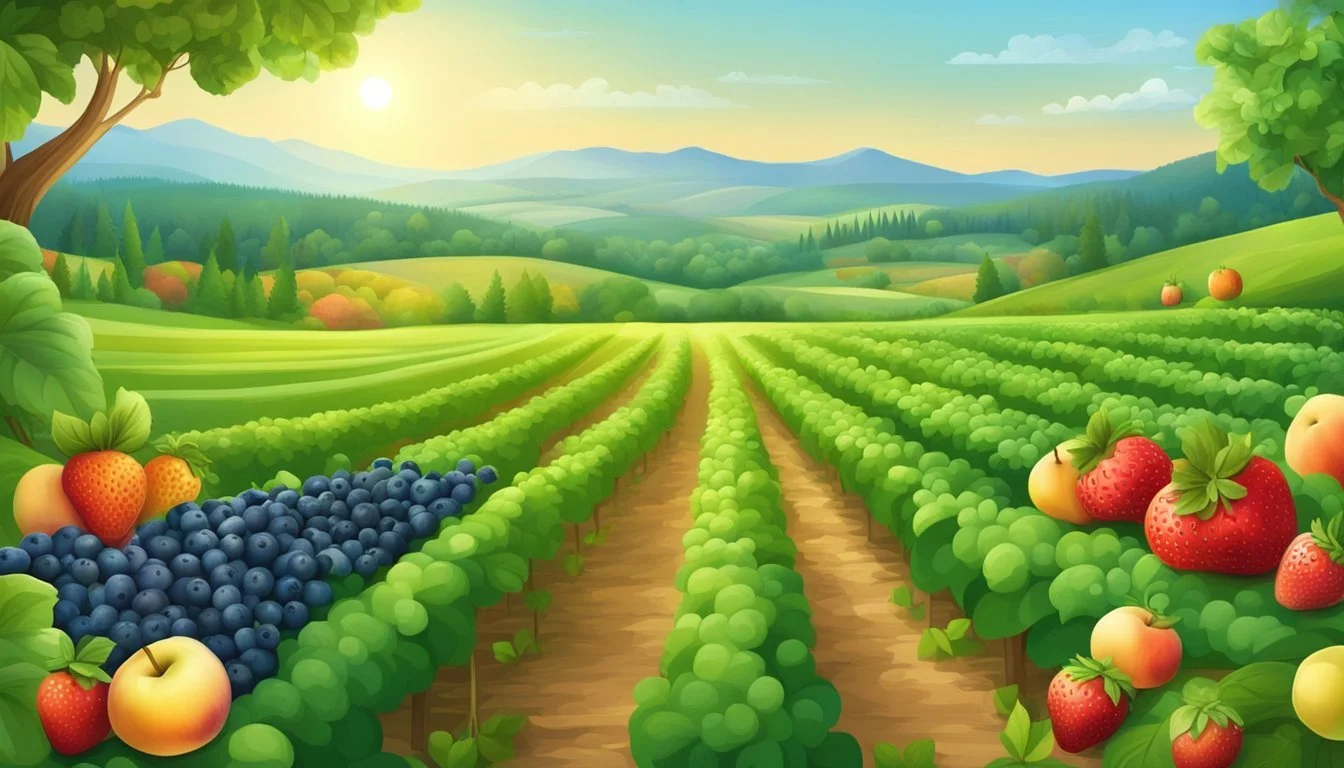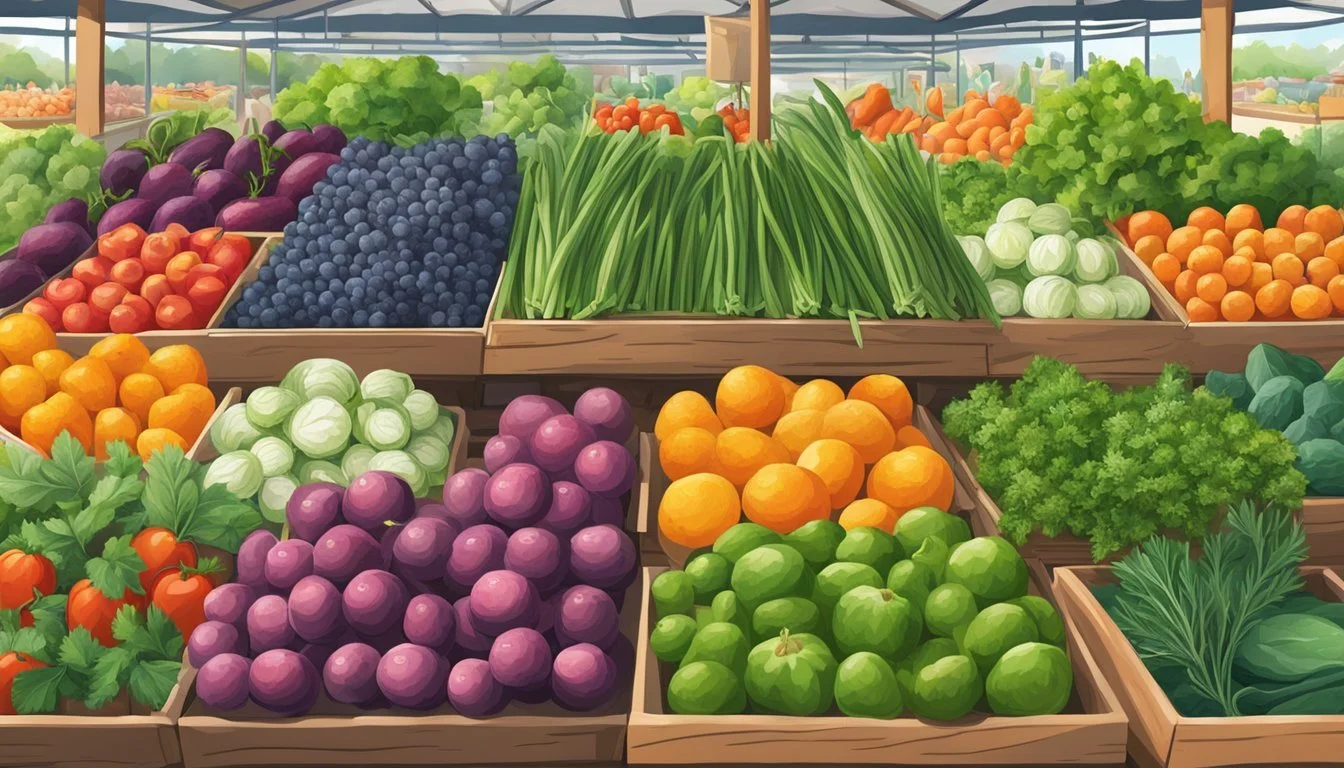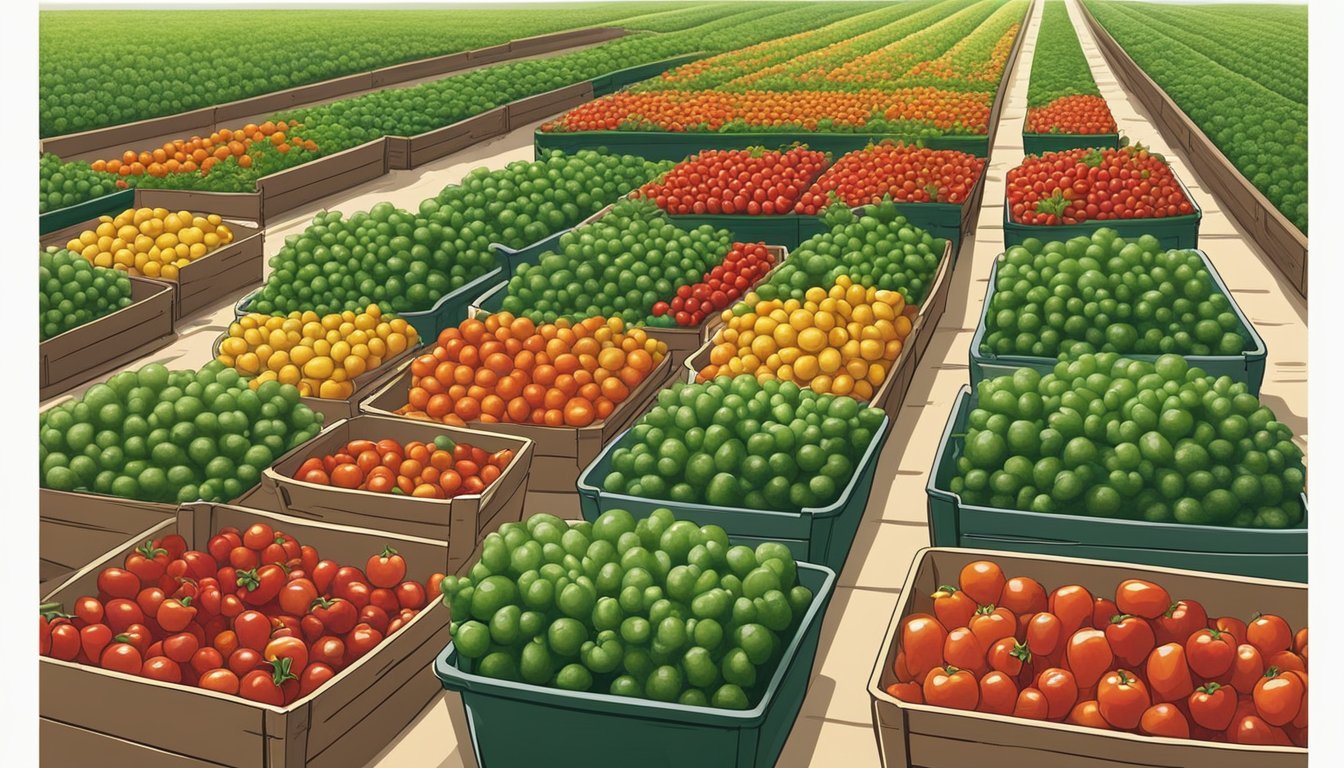Oklahoma Seasonal Fruit & Vegetables in May
Your Fresh Picks Guide
This Article is Part of our Oklahoma Seasonal Fruit & Veg Calendar
In Oklahoma, the arrival of May signals a pivotal transition in the agricultural calendar, ushering in the bounty of spring harvests. This period is characterized by longer, warmer days that are highly conducive to the growth of a variety of fruits and vegetables. As local farmers and gardeners welcome the shift, markets begin to showcase an array of fresh, seasonal produce. Oklahoma's climate, with its distinct seasons, has a considerable influence on the cycles of planting and harvesting, making each month's yield unique.
The selection of fruits and vegetables available in May is particularly diverse, as spring reaches its peak. Early spring crops continue to thrive, while preparations for summer plantings are underway. Consumers can find fresh greens like spinach and lettuce, as well as root vegetables such as radishes and beets, that have been nurtured in the cool-to-moderate temperatures of preceding months. The fruit spectrum begins to broaden, with strawberries typically reaching their peak, offering that perfect balance of sweetness and acidity.
Moreover, May introduces an increased variety of produce that extends beyond the cool season favorites. Items like asparagus are in their prime, and the much-anticipated first harvests of summer-season crops, like squash and cucumbers (how long do cucumbers last?), emerge at the tail end of the month. This versatility enables both consumers and chefs to experiment with a wide range of flavors and textures, sparking creativity in the kitchen while supporting Oklahoma's local agriculture and fostering a deeper connection with the seasonal food cycle.
Planning Your Garden
When planning a garden in Oklahoma during May, gardeners should consider the state's diverse hardiness zones and select plant varieties suited to the region's climate and soil. Success hinges on understanding the local environment and choosing the right plants that will thrive under those conditions.
Understanding Oklahoma's Hardiness Zones
Oklahoma is characterized by a range of hardiness zones, influencing what plants will survive and prosper. These zones range from 6a in the northwestern regions to 7b in the southeastern parts of the state. The hardiness zone determines the type of plants suited for the area based on the average minimum winter temperature. Gardeners should consult a hardiness zone map to identify their specific zone before planning their garden.
Sunlight: Plants in Oklahoma typically require ample sunlight, with a minimum of six hours of direct sunlight being ideal for most vegetables.
Fertilizer: Using fertilizer should be done cautiously, considering the type suitable for the selected plants and the local soil conditions.
Watering: Regular watering is crucial, but the frequency and amount will depend on the local weather patterns and soil drainage capacity.
Selecting the Right Varieties
Choosing plant varieties that are recommended for Oklahoma's May climate is essential. Gardeners should opt for warm-season vegetables and fruits that can be planted after the last frost date, which has usually passed in May.
Vegetables:
Tomatoes: They need well-drained soil and at least 8 hours of sunlight.
Peppers: These require similar conditions to tomatoes and benefit from consistent watering.
Fruits:
Melons: They thrive in full sun and need space to spread.
Strawberries: Best planted earlier, but can still be managed in May for a later harvest.
To aid in plant growth and survival, gardeners should incorporate organic matter into the soil to improve its fertility and moisture retention. They must also ensure proper spacing between plants for adequate air circulation and growth.
Starting Your Plants
In Oklahoma, May is a prime time for gardeners to start plants. With the last frost typically behind them, gardeners can focus on indoor seed starting and transplanting seedlings to ensure a bountiful harvest through summer and fall.
Indoor Seed Starting
Gardeners should utilize the stable conditions inside to start seeds (how long do seeds last?) for heat-loving summer crops. It's the perfect opportunity to initiate the growth of plants like tomatoes, peppers, and eggplants, as they need a warm start free from the risks of late frosts that can occasionally occur in early spring. When starting seeds indoors, one should focus on:
Consistent temperatures: Maintain a range of 65-75°F for optimal germination.
Adequate light: Seedlings need plenty of light; a south-facing window or grow lights can provide this.
Using seed starting mix in trays or pots marked with the plant name and date sown.
Transplanting Seedlings
Once seedlings have grown strong enough indoors and the danger of frost has passed, they are ready for transplanting into the garden. Key steps in this process include:
Hardening Off: Gradually acclimatize seedlings to outdoor conditions by exposing them to increased hours of outdoor light and temperatures for 7-10 days.
Soil Preparation: Ensure the soil is well-tilled, moist, and rich in organic matter for transplantation.
Timing: Transplant in the late afternoon or on a cloudy day to reduce shock from sun and heat.
Planting dates for seedlings should follow recommendations for Oklahoma USDA Hardiness Zones, typically ranging from Zone 6 to Zone 8. Gardeners must monitor the weather closely, as late spring can sometimes bring unexpected cold snaps that may necessitate protective measures for tender young plants.
Fruits and Berries in Season
In May, Oklahoma welcomes an array of fruits and berries that offer a sweet and fresh taste of the season’s bounty. The focus is primarily on the delightful variety of berries that start to peak, as well as the early stone fruits that arrive as harbingers of the summer months.
Berry Varieties
May in Oklahoma signals the beginning of berry season. Strawberries often take the lead, being among the first to appear at local markets. Consumers can enjoy these juicy, red berries that are perfect for eating fresh or using in desserts. Another popular berry is the blueberry, celebrated for its versatility and health benefits. As the month progresses, blackberries and raspberries also start to make their debut. These berries provide a balance of sweet and tart flavors, suitable for a variety of culinary uses.
Strawberries: Peak availability, ideal for fresh consumption and desserts.
Blueberries: Beginning of the season, nutritious and versatile.
Blackberries: Starting to arrive; great for jams and baking.
Raspberries: Emerging in markets; perfect for dressings and toppings.
Tree Fruits
The stone fruit season is ushered in during May, though it's typically a prelude to the more abundant summer months. Peaches are among the tree fruits that start to show up, marking the promise of summer with their fuzzy skin and sweet flesh. While you might find limited quantities of early varieties, these tree fruits suggest a richer yield as warmer weather approaches.
Peaches: Early varieties available, signaling the start of stone fruit season.
It should be noted that while some tree fruits like apples (how long do apples last?) are often available year-round in grocery stores due to storage and importation, local Oklahoma variants are not in season during May. Local apple varieties are best enjoyed in the fall. Other fruits such as figs do not typically peak until later in the year and are not a primary focus for the month of May in Oklahoma.
Vegetable Harvesting
In May, Oklahoma's soil and climate become conducive to harvesting a variety of vegetables. The focus shifts to tender leafy greens, newly matured root vegetables, and the early bounty of summer staples that thrive in the state’s temperate spring weather.
Leafy Greens
Lettuce: Varieties such as romaine and leaf lettuces are ripe for picking, offering crisp textures and fresh flavors.
Spinach: Harvesting of spinach is in full swing, with its leaves at the peak of tenderness and nutritional content.
Chard: Chard, with its colorful stems and nutrient-rich leaves, is also ready to be picked, adding variety to the greens selection.
Root Vegetables
Carrots: They have reached their sweet, crunchy maturity, ideal for harvesting.
Radishes: Quick to mature, radishes offer a peppery kick and are harvested at their crisp best.
Beets: Known for their earthy flavor and vibrant color, beets are now ready to be pulled from the ground.
Summer Staples
Tomatoes: Although still early in the season, some early varieties of tomatoes may be ready for harvest, particularly in warmer microclimates within the state.
Peppers: Certain early pepper varieties can begin to be harvested, though most will peak later in the summer.
Cucumbers: Greenhouses and warm soils yield early cucumber harvests, with their refreshing taste.
Summer Squash: Including zucchini, harvest begins now and will continue throughout the summer.
Corn: While May is still early, some early varieties of corn might be ready for harvest in the warmest areas of Oklahoma.
Herbs and Seasoning
During May in Oklahoma, gardeners and cooks can benefit from a variety of herbs available. One prominent herb that thrives in May is sage. Known for its fragrant leaves, sage is a hardy perennial that can enhance a multitude of dishes, from roasted meats (What wine goes well with roasted meats?) to savory butters.
Sage
Type: Perennial herb
Uses: Often used in poultry and pork dishes, infused in oils, and added to stuffings.
Growing: Requires well-drained soil and can tolerate dry, arid conditions.
Harvesting: Sage is best harvested before blooming for optimal flavor. Leaves can be picked as needed.
In addition to sage, other culinary herbs suitable for Oklahoma gardens in May include:
Cilantro: Prefers cooler temperatures and can bolt in the heat.
Parsley: A biennial that provides fresh leaves in its first year.
Chives: A perennial with onion-flavored leaves, perfect for salads and egg dishes.
Planting Tips:
Ensure proper sunlight and water for each herb type.
Include mulch around the base to retain moisture and regulate soil temperature.
Prune regularly to promote growth and prevent bolting.
Gardeners may start these herbs from seed or purchase them as young plants from a garden center. By selecting the right herbs for the season and providing them with the care they need, one can enjoy a fresh, flavorful harvest right from their backyard.
Maintenance and Care
Successful cultivation of fruits and vegetables in Oklahoma during May requires diligent maintenance and care. Key components of this process involve managing pests and diseases, as well as consistent weeding and mulching to promote healthy plant growth.
Pest and Disease Management
In May, Oklahoma gardeners must be vigilant in monitoring for pests and diseases. Common pests such as aphids, spider mites, and squash vine borers can be detrimental to vegetable crops if not managed properly. Regular inspections can lead to early detection and control. Gardeners should use appropriate pesticides or natural remedies such as neem oil or insecticidal soap to keep pest populations in check. Diseases like powdery mildew and blight often thrive in the moisture of late spring; thus, ensuring good air circulation around plants and applying fungicides when necessary helps prevent the spread of these diseases.
Weeding and Mulching
Consistent weeding is crucial to prevent competition for nutrients and water. Gardeners should remove weeds by hand or with a hoe, taking care not to disturb the roots of the vegetables. Mulching serves multiple purposes: it helps retain soil moisture, regulates soil temperature, and suppresses weed growth. Materials commonly used for mulching include straw, wood chips, or compost. A 2-3 inch layer of mulch should be sufficient to provide these benefits without risking the introduction of pests or diseases hidden in the material.
Harvest and Post-Harvest
May in Oklahoma brings a diverse bounty of fruits and vegetables that are ready to be harvested. Proper techniques ensure the peak flavor of produce, while effective storage and preservation methods extend their usability beyond their fresh state.
Harvesting Techniques
Harvest times for Oklahoma produce in May can vary based on local climate conditions. One should harvest strawberries in the early morning cool, which helps retain their flavor and prolongs shelf life. Cool-season vegetables like lettuce and spinach are also best harvested now, before the midday heat, to maintain crispness and freshness. Farmers utilize signs of ripeness such as firmness and color change in crops like snap beans to determine the perfect harvesting window.
Storage and Preservation
Preservation and storage practices for May’s harvest focus on maintaining the quality of produce until consumption. Many vegetables, like asparagus, should be stored upright in cool, moist conditions, often in refrigerators with stems in water to keep them tender. For fruits such as strawberries, one should remove any damaged or overly ripe berries to prevent mold and then store them in the refrigerator; they also freeze well for long-term storage. Meanwhile, herbs can be tied and hung to dry or can be preserved in oils or vinegars to retain their aromatic flavors for use in recipes.
Enjoying the Produce
May in Oklahoma offers ample opportunities for locals and visitors alike to enjoy fresh produce through various avenues. The abundance is notable in the state's vibrant farmers markets and the diverse range of home-cooked dishes.
Farmers Markets
In Oklahoma City, Tulsa, and Broken Arrow, farmers markets become a hub for the community to procure fresh, seasonal produce directly from local growers. Visitors can expect to find an array of fruits and vegetables, such as the KIKU® apple, ripe and ready for consumption. The interaction with farmers offers insights into the best selections and tips on how to enjoy their produce.
Oklahoma City: Wide range of local vendors with seasonal specialties.
Tulsa: Known for offering organic and heirloom varieties.
Broken Arrow: Hosts a smaller-scale market fostering a close-knit community feel.
Home Cooking and Recipes
The fresh produce obtained from these markets can significantly elevate the quality and taste of home-cooked meals. With fruits like sweet KIKU® apples available, they can inspire a variety of recipes from refreshing apple salads to hearty pies. For those residing in or visiting Oklahoma, incorporating these seasonal ingredients into recipes not only supports local agriculture but also introduces a palette of flavors that are unique to the season's offering.
Recipes to Try:
KIKU® Apple Salad: Thinly sliced apples tossed with a vinaigrette.
Baked Apple Delight: KIKU® apples baked with cinnamon and nutmeg (how long does nutmeg last?), perfect for a May dessert.
Preparing for the Next Season
May in Oklahoma presents gardeners with unique challenges and opportunities as the transition from spring to summer takes place. It's essential to consider frost dates when planning; although the risk of frost typically diminishes by late April, gardeners should remain vigilant for any late-season cold snaps.
Heat, on the other hand, begins to set in, making it crucial for gardeners to prepare their soil for increased temperatures. They can do this by:
Mulching to retain soil moisture
Ensuring adequate irrigation systems are in place
Planting heat-tolerant varieties of fruits and vegetables
Gardeners should also plan for shade to protect sensitive crops as the Oklahoma sun intensifies. This may involve:
Using row covers
Strategically planting taller crops to provide natural shade for lower-growing plants
When planning the garden, gardeners must consider the space and timing for each crop. Below is a concise table highlighting key fruits and vegetables to plant in May:
Planting in May Harvest Period Sweet Corn Late Summer to Early Fall Summer Squash Early to Mid Summer Cucumbers Early to Mid Summer Green Beans Early to Mid Summer Tomatoes (transplants) Late Summer
It benefits gardeners to utilize their knowledge of local climate patterns to adjust their planting strategies. They should earmark space for late-season crops while harvesting earlier ones. In doing so, they'll maximize their garden's yield and enjoy a diverse harvest throughout the coming months.











